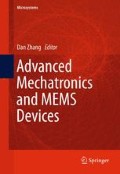Abstract
A key operation in assembly of MEMS optical switches is to insert fibers into U-grooves on a silicon substrate. Due to the limited positioning accuracy of the handling tool, heavy collision often occurs between fibers and the edges of U-grooves during the insertion operation. Such collisions will not only damage fibers and U-grooves but also sometimes make the fiber skidding from the handling tool. Conventional solutions to the problem involve determining misalignment using machine vision or force sensors, and then positioning fibers accurately by virtue of high precision multiaxis positioning systems (with submicron repeatability). However, such approaches are costly and difficult to implement. In this chapter, we present a cost-effective passive assembly method to solve the problem. It utilizes a specially designed passive flexure-based fixture (stage) to regulate high contact forces and accommodate assembly errors. To determine the design conditions for a successful insertion, the major problems encountered during the fiber insertion are analyzed. A systematic design method is then proposed for a 3-legged Flexure-based Parallel-Kinematics Stage (FPKS) for passive assembly applications. Experimental results show that such a passive assembly approach can effectively and automatically reduce the contact force and accommodate the assembly errors.
Access this chapter
Tax calculation will be finalised at checkout
Purchases are for personal use only
References
Ralis SJ, Vikramaditya B, Nelson BJ (2000) Micropositioning of a weakly calibrated microassembly system using coarse-to-fine visual serving strategies. IEEE Trans Electron Packag Manuf 23(2):123–131
Vikramaditya B, Nelson BJ, Ge Y, Enikov ET (2001) Microassembly of hybrid magnetic MEMS. J Micromechatron 1(2):99–116
Yamamoto Y, Hashimoto T et al (2002) Measurement of force sensory information in ultra-precision assembly tasks. IEEE Trans Mechatron 7(2):186–189
Brussel HV, Peirs J, Reynaerts D et al (2000) Assembly of microsystems. Annals CIRP 49(2):451–472
Chen WJ, Lin W, Low KH, Yang G (2005) A 3-D of flexure-based fixture for optical MEMS switch assembly. In: IEEE/ASME international conference on advanced intelligent mechatronics, Monterey, CA, USA, 24–28 July 2005
Chen WJ, Lin W (2008) Fiber assembly for MEMS switch with U-groove channels. IEEE Trans Autom Sci Eng 5(2):207–215
Peshkin MA (1990) Programmed compliance for error corrective assembly. IEEE Trans Robot Autom 6(4):473–482
Gosselin C (1990) Stiffness mapping for parallel manipulators. IEEE Trans Robot Autom 6(3):377–382
Whitney DE (1982) Quasi-static assembly of compliantly supported rigid parts. Trans ASME J Dyn Syst Meas Contr 104:65–77
Griffis M, Duffy J (1991) Kinestatic control: a novel theory for simultaneously regulating force and displacement. ASME Trans J Mech Des 113:508–515
Wang ZF, Cao W, Shan XC et al (2004) Development of a 1 × 4 MEMS-based optical switch. Sensor Actuator 114:80–87
Castilone RJ (2001) Mechanical reliability: applied stress design guideline, Corning White Paper, WP5053
Howell LL (2001) Compliant mechanisms. Wiley, New York
Lipkin H, Petterson T (1992) Generalized center of compliance and stiffness. In: Proceedings of IEEE international conference on robotics and automations, Nice, France, vol 2. pp 1251–1256, May 1992
Bonev LA, Zlatanov D, Gosselin CM (2003) Singularity analysis of 3-D of planar parallel mechanisms via screw theory. ASME Trans J Mech Des 125:573–580
Kim WK, Yi BJ, Cho W (2000) RCC characteristics of planar/spherical three degree-of freedom parallel mechanism with joint compliances. Trans ASME J Mech Des 122:10–16
Alexander HS (1992) Precision machine design. Prentice Hall, NJ. ISBN 0-13-690918-3
Author information
Authors and Affiliations
Corresponding author
Editor information
Editors and Affiliations
Rights and permissions
Copyright information
© 2013 Springer Science+Business Media New York
About this chapter
Cite this chapter
Chen, W., Yang, G., Lin, W. (2013). Flexure-Based Parallel-Kinematics Stages for Passive Assembly of MEMS Optical Switches. In: Zhang, D. (eds) Advanced Mechatronics and MEMS Devices. Microsystems, vol 23. Springer, New York, NY. https://doi.org/10.1007/978-1-4419-9985-6_6
Download citation
DOI: https://doi.org/10.1007/978-1-4419-9985-6_6
Published:
Publisher Name: Springer, New York, NY
Print ISBN: 978-1-4419-9984-9
Online ISBN: 978-1-4419-9985-6
eBook Packages: EngineeringEngineering (R0)

